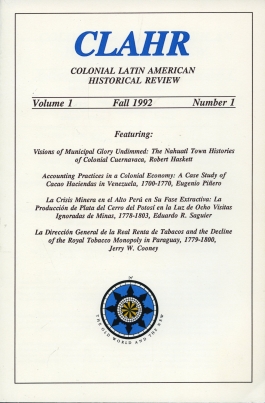Colonial Latin American Historical Review
Volume 8, Issue 3 (Summer 1999)
From the Editor's Desk
This special issue of CLAHR is dedicated to the history of medicine in Spanish America during the colonial period. Richard Greenleaf's portrayal of a sixteenth-century doctor in Mexico offers a glimpse into the life and times of Dr. Pedro López. Given the shortage of doctors in Mexico, physicians led somewhat privileged lives. When Inquisition officials investigated charges that Dr. López was a "relapsed Jew," they refused to have him arrested because he was a much needed member of society. In the following years, Dr. López proved his worthiness as a Christian through "his conspicuous good works and philanthropy."Francisco Guerra's study traces the evolution of typhus in Mexico. He compares the pre-Columbian type of typhus with the strain introduced by the Europeans in the Americas and focuses on the death toll of this new strain among the indigenous population. Guerra, a medical doctor, couples his scientific knowledge with descriptions about the disease given by chroniclers and other colonial-period sources.
Yolanda Texera Arnal has uncovered another side to the licensing of medical personnel in colonial Venezuela. Due to the shortage of European doctors in 1777, Black curanderos, especially those who had practiced surgery, were permitted to work as doctors in Venezuela. After sixteen years, in 1793, it was decided by the Protomedicato, the royal medical board, that conditions had changed and that the service of Black curanderos were no longer needed. Texera Arnal investigates the ethnocentrism that contributed to the reversal of permitting Blacks to practice medicine in the general public.
Jan G.R. Elferink focuses on the use of poison among the Incas, who invoked social controls against those who used their medical knowledge to "obtain a certain effect," such as murder, at a time when poisonous concoctions could not be traced in the human body.
Finally, Joseph P. Sánchez's unedited transcription reveals the story of José Miguel Múñnoz who invented a metal prosthesis that could imitate the action of a human leg. That it was invented in Mexico in 1816 has been largely overlooked by researchers of science and medicine.
Medicine as practiced by physicians in Spanish America is a much ignored subject. The image of the country doctor that exists in the English tradition often gies way to te image of the curandero in the Spanish realm. Similarly, the folk medicine practiced by both Europeans and native groups in the Americas has created at least one stereotype that depicts Latin American colonial society as unscientific in regard to health care. This volume is unique in its effort to present sources for future studies on the history of medicine in colonial Latin America.
Articles
"Padre de los Pobres:" Dr. Pedro López of Sixteenth-Century Mexico
Richard E. Greenleaf
Origen y efectos demográficos del tifo en el México colonial
Francisco Guerra
Médicos y cirujanos pardos "en condición de por ahora" en la Provincia de Venezuela, siglo XVIII
Yolanda Texera Arnal
The Use of Poison and Malevolent Magic in Criminal Practices among the Incas in Pre-Columbian Peru
Jan G.R. Elferink
José Miguel Múñoz, the Mexican Real Hacienda, and the Invention of the Prototype Modern Prosthesis, 1816: Un Documento Inédito
Joseph P. Sánchez
Book Reviews
Kathryn Burns, Colonial Habits: Convents and the Spiritual Economy of Cuzco, Peru
Sister Maria Consuelo Sparks
Luis F. Calero, Chiefdoms under Siege: Spain's Rule and Native Adaptation in the Southern Colombian Andes, 1535-1700
Larry Larrichio
Amos Megged, Exporting the Catholic Reformation: Local Religion in Early-Colonial Mexico
Patrick Foley
Luz María Hernández Sáenz, Learning to Heal: The Medical Profession in Colonial Mexico, 1767-1831
Pamela Voekel
Full Issue
Full Issue
Spanish Colonial Research Center

Editors
- Editor
- Joseph P. Sánchez
- Managing Editor
- Angélica Sánchez-Clark
- Associate Editor
- Patrick J.F. Killinger
- Editorial Assistant
- Pacífica Casáres
- Editorial Assistant
- Erlinda Maes
